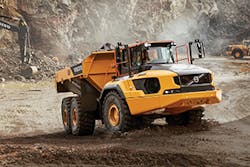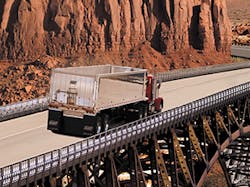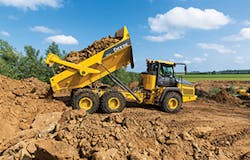Industry experts agree that choosing between a rigid or articulated dump truck (ADT) depends on the job.
Aaron Kleingartner, the marketing manager for Doosan Construction Equipment, notes that articulated dump trucks (ADTs) are the most common truck used in off-road construction job sites in the US and Canada.
“An ADT is the preferred method to haul materials anytime a company is working in an off-road situation such as an open job site,” he says. “ADTs have better capability to easily traverse muddy or soft terrain with six wheels versus four on a rigid dump truck.”
Six wheels spread out the articulated dump truck’s load over a larger area, Kleingartner points out.
“Also, ADTs require a narrower area to turn,” he says. “That may seem odd when you consider open job sites; however, many operators want to stay within a narrow path or area when operating versus making wide turns on the surface each time the truck is loaded and carries material from point A to point B.”
An ADT’s ability to articulate and oscillate makes them a contractor’s preference on many job sites, points out Scott Thomas, product application specialist for articulated trucks, Caterpillar.
“It has a six-wheel drive for a reason because you use those for greenfield sites where you’re stripping, digging a retention pond, or digging a new subdivision, you don’t have well-maintained, well-drained haul roads, and the job site is zero to a few years long,” he says.
“Articulated trucks can go upwards of 30 to 35% grade on a road—the sweet spot would be 20 to 30. The flatter the better in terms of productivity, but with articulated trucks, most contractors already know where they’re going to go. They’re going to be paired up with an excavator, a wheel loader, move a lot of dirt, and do a lot of overburden where they need a six-wheel drive.”
Jay Quatro, product application and training specialist for Wacker Neuson, notes that the compact size and 180-degree rotating skip of ADTs allow for precise material placement in a variety of conditions, such as in site excavation, landscaping, golf courses, cemeteries, and demolition, among other applications.
Scott Ruderman, product specialist, working gear, Komatsu America, adds that ADTs are better suited for when well-maintained haul roads are not available and are more versatile because they can go almost anywhere and are a good fit when moving from job to job, especially short-term jobs.
Maryanne Graves, product marketing manager, ADTs, John Deere Construction & Forestry, adds that the application of the equipment or the job itself is another consideration.
“A lot of times, the loading tool the customer has onsite already is going to dictate the type of truck they need and whether that’s going to be an ADT or a rigid frame truck, so it’s based on the size of the loader or excavator,” says Graves.
The length and size of the job is another consideration.
“Some quarry and mine jobs are 20- to 30-year jobs, so if you’re not looking to move that machine from site to site, it may make sense to have a rigid frame on that site,” points out Graves. “As well as being maneuverable on the job site, ADTs are easier to move from job site to job site.”
Small capacity dump trucks are often used on smaller road-building projects where there is not much room to maneuver, notes Graves.
“Once you get into some of those quarries and mines, contractors are looking for more payload and that cost per ton. They’re looking at a larger truck—our largest truck is rated to haul 46 short tons. That’s going to move a lot more material faster.”
Charlie Wells, vice president of sales and marketing for East Manufacturing, notes that in a “straight truck versus a tractor-trailer dump application, you can typically get a greater payload with a tractor-trailer simply because there are greater distances between the axle groups to meet the Bridge Formula.”
It’s more difficult to get a higher payload in a straight truck, he adds.
“Construction companies will often choose a straight truck in asphalt paving and inner-city work,” he says. “But a multi-axle, seven-axle tractor-trailer is a good alternative. Often the contracting companies will promote the use of one or the other.“
Bridge Laws and weight restrictions often drive the specification, while there are exceptions to the rule, says Wells.
“Pennsylvania has unique laws that allow the straight truck to carry as much payload as a tractor-trailer,” he adds. “In a long-distance application greater than 100 miles, we see more tractor-trailer configurations. Recruiting drivers for a straight truck is often easier than for a tractor-trailer.”
A straight truck is typically costlier to operate, notes Wells.
“If you’re trying to carry a maximum gross load, a straight truck is ideal,” he adds. “Generally, the tractor-trailer can carry more legal payload more cost-effectively.”
The length of a truck has to be balanced on any type of dump equipment, says Wells.
“Length is part of the Bridge Formula equation, so it has to be taken into account for maximum loads,” he adds. “Length is the enemy to a dump truck or tractor-trailer. The longer the dump unit, the less stable it is when it’s hoisted in the air.”
Rigid trucks are better suited for operating at longer-term job sites with well-maintained haul roads, which provide a lower tire rolling resistance, such as a limestone quarry, Ruderman says, adding that rigid trucks can typically offer a lower total cost of ownership.
A graded surface, such as found in mining applications, is another area in which a rigid dump truck is best suited, says Kleingartner, adding that they also typically have larger capacities than ADTs.
Thomas concurs that a rigid frame is chosen for those jobs that could last years or decades, such as at a quarry.
“They are only rear wheel drive, so they need constant manicured haul road and grades,” he adds. “They can handle 15 to 20% grades, but the sweet spot for a rigid frame is about 10 to 12%.”
In choosing the size of a truck for the job, Thomas notes that it correlates with the size of a company as well as geographic location.
An East Manufacturing Genesis frame dump on the road
“The bigger the company, the bigger the excavator, the bigger the motor grader, the bigger the track-type tractor,” he says. “You’re going to go out and pursue and bid and win those jobs that move millions of yards of dirt. You want the biggest capacity machine out there.”
Work conducted in the Northeast or in locales where roads aren’t wide required smaller machines paired up with a smaller excavator, Thomas says. He points out that much of the work done in Europe is done with smaller equipment, whereas in the US, with its wide roads and high bridges, the equipment goes as high as 45 tons.
Versatility, reliability, and availability are the prime driving factors in choosing a dump truck, notes Rob Palermo, product manager, Volvo Construction Equipment.
Versatility in the sense of being able to use a truck with a wide range of loading tools—be it a wheel loader or excavator already in the fleet or being rented—will determine the size of the articulated truck to use, says Palermo.
Palermo recommends pass matching, “which means the proper number of buckets for the loading tool compared to the articulated hauler being used. That is sized by needs as far as production, total tonnage, distance of travel, haul roads.”
To that end, Volvo also offers site simulation to help map out a site to pull together the best fleet of equipment choice for a job.
“Practically speaking, the size of the truck has a direct impact on how fast the loading apparatus, such as a crawler excavator or wheel loader, can fill the truck and how much material it can transport,” says Kleingartner. “The Association of Equipment Manufacturers classifies ADTs and approximately 80% of ADT sales in the United States and Canada fall in two categories—30 and 40 tons—which is why Doosan offers a truck in these size classes.”
When a construction firm is choosing between the 30- and 40-ton size classes, the decision-maker will evaluate the job site conditions, loading apparatus, and travel distance between loading and unloading, he adds.
“The next question is how many trucks does a construction firm need? Generally speaking—and this will depend a lot on the job site and how much material is being moved—but the fleet manager or job site superintendent should always have the loading apparatus working and trucks in motion. As an example, a large crawler excavator may load a truck in three or four passes, loading as many as 15 to 20 ADTs on a job site.”
In terms of versatility, smaller ADTs are more popular in rental fleets because they are easier to manage and provide a lower utilization cost for owners, Kleingartner adds.
“A consideration for fleet managers is a rear tailgate or no tailgate,” he says. “Many ADTs are sold with a rear tailgate because they better help hold materials, such as dry sand that will flow better than wet clay.”
Options abound in the marketplace.
Volvo Construction Equipment offers a range of articulated dump trucks from the 25-ton A25G to the 60-ton A60H. They all feature the same design concept, with rigid front and rear frames, articulation, oscillation, three axles, and multiple drive configurations. Model A45 has two configurations: a standard suspension and a full suspension.
Caterpillar’s lineup includes the 26-ton 725E2, the 31-ton 730C2, and the 36-ton 735C, all of which are tippers. The 31-ton 730C2 and the 42-ton 740EJ are ejectors. Completing the lineup is the 45.2-ton 745.
Komatsu offers the Komatsu Traction Control System on its six smallest models to maximize tire life and minimize cycle time when the job site becomes slippery, says Ruderman.
The company’s trucks feature different hauling capabilities.
“The larger the truck, the higher the payload capacity, but care must be taken to set up the job site so the type and number of trucks match up to the loading tool and to meet desired production targets,” says Ruderman.
Because bigger trucks are typically less versatile and are best suited for a specific long-term job, they are also more difficult and costly to transport and often require disassembly or trucking escorts depending on local regulations, he adds.
“Medium to smaller trucks offer ease of transport and can be adapted to a larger range of jobs more easily,” notes Ruderman.
Ruderman says both Komatsu’s articulated and rigid truck lines are designed with optimal turning radii—even on the larger models—“which provides maneuverability to increase operator confidence. This helps even a larger truck feel maneuverable to the operator.
“The size of the truck, weight of the payload, the tire size, and tire tread pattern all impact the applications a truck can operate in.”
Wacker Neuson provides a line of articulated off-road dump trucks that range in payload from 6,614 to 19,842 pounds.
A truck’s size can impact usage in two major ways—site access and ground disturbance, notes Quatro, adding that choosing one type of dump truck over another can enable a contractor greater access to work on a variety of sites.
John Deere offers five models of articulated dump trucks: the 260E, 310E, 370E, 410E, and the largest, the 460E. The two smaller models were introduced in February 2017. The models are streamlined to provide consistent features.
The differentiating factor among the models is payload capacity. All of the models were streamlined across the board for benefits and safety features, Graves says.
“The 260E and 310E are beneficial on job sites where they don’t have as much space to move around and need more maneuverability,” says Graves.
All five models have auto-diff lock.
“In soft underfoot conditions, it’s going to engage and disengage as necessary,” says Graves. “When an operator sees some material approaching they need to power through, they can engage the diff lock on the fly. While all five of the John Deere models can operate under those conditions, it’s really the size of the job that’s going to dictate the size of the truck that’s needed.”
Usage of telematics and fleet management technology is increasing in the grading and excavating industry, although not as fast as in the freight business, Wells notes.
“Depending on the fleet, there are some that have the latest and greatest technology like Qualcomm,” he says. “The makeup of the dump business is impulsive so the technology is valuable.”
Most non-road construction equipment, including trucks, is equipped with telematics or a fleet management system to better manage the machines, notes Kleingartner.
“Doosan ADTs, like many other brands, have telematics systems included as standard equipment. The DoosanCONNECT telematics system comes standard with Doosan ADTs for 36 months of service, providing owners and fleet managers with more information about the machine and its performance,” he says.
The John Deere 310E at work
A load count or weight measurement is an example of the type of information provided in telematics data, notes Kleingartner.
“An optional load scale is available for Doosan DA30-5 and DA40-5 ADTs,” he adds. “It counts the number of times the dump body has been emptied and it can tell owners and fleet managers how much material a truck has handled in a specific timeframe. This is beneficial to help an owner determine if he needs another truck to help improve job site productivity.”
For telematics, Caterpillar offers Payload on its trucks as an option. Payload offers operators the ability to track productivity in payload weights, load and cycle counts, and daily totals from the cab.
It can be combined with VisionLink technologies’ two service levels—one being a daily total and the other being hourly, says Thomas, adding that VisionLink is standard on the trucks.
“You also can monitor fuel, location, alerts, and service codes and have it set up to where it will let you know when you want when it’s time for an oil change,” he adds. “You can plan your day out and your job site out.”
Komatsu’s Business Solutions Group provides contractors a job site study to provide an Optimum Fleet Recommendation to correctly match trucks, loading tools, and site conditions.
Komatsu’s Tier 4 Final rigid and articulated trucks come equipped standard with the latest version of KOMTRAX, Komatsu’s equipment monitoring telematics system. KOMTRAX data can be accessed anywhere through a computer or smartphone.
The telematics data can be used to view a single machine or a fleet of machines, providing information including payload data, machine hours, fuel consumption, operation idle time, or cautions about abnormalities. Automatic alerts can be sent to a phone.
Telematics also is helping to drive efficiencies in Volvo’s articulated trucks.
CareTrack is an onboard weighing technology that enables a machine’s productivity with respect to load efficiency, number of cycles, and overload percentages, notes Palermo, adding that it also helps contracting operations identify training needs.
ActiveCare Direct is a telematics machine monitoring and fleet utilization reporting service offered by Volvo. It captures CareTrack machine data points and sends them to the Volvo Uptime Center in Shippensburg, PA, where data analysts analyze machine health in real time.
Contractors receive a monthly fleet utilization report to help identify worksite efficiency opportunities and machine issues.
Haul Assist, a multi-app, multi-layer interactive touchpad inside of the machine, is expected to be launched in 2018, with the initial launch being an onboard weighing app that together with CoPilot—a new in-cab interactive monitor—will update current onboard weighing features with more parameters and more offboard recording. Together with CoPilot, it will offer more parameters for reporting, Palermo notes.
Future apps will look at mapping and speed “to give the operators the ability to know where all of the other trucks are on the job site and the just in time loading, so the truck will go and the app will report back to the operator his or her best speed to have the best fuel consumption in the haul cycles.”
John Deere utilizes JDLink for telematics. It comes standard on all of the ADTs. Onboard weighing is an option on all five models, enabling the contractor to view what’s being loaded in real time, with the onboard weighing system communicating with JDLink so contractors are able to manage how much material they’re moving each day on the job site.
John Deere also offers a machine monitoring center that looks at the overall health of its machines, with the information used by contractors, dealers, and the company, in an effort to pre-empt failures.
“We’re looking at codes and symptoms being sent to the machine monitoring center and allowing us to get out in front and make sure that uptime is maximized as best as possible by our customers because we know how critical that is on our production-class equipment,” says Graves.
Wacker Neuson offers telematics packages for all of its compact equipment, including its site dumpers, enabling a machine owner or project manager to monitor critical machine functions and location remotely, including from a smartphone, says Quatro.
Wells notes an increase in the use of automatic and automated transmission technology in dump trucks.
“Ten years ago, it was a novelty, but now it’s commonplace to help fleets recruit and retain drivers,” he points out. “Since the high-cycle constant stopping and starting wears the driver out, automatic transmissions are becoming more and more popular, even though they’re costlier.”
ADTs are designed with three braking systems, notes Kleingartner.
“The transmission retarder is the primary ADT braking mechanism. Through friction, the retarder reduces the rotational force in the transmission. The second braking system is the engine brake, and the final braking system is the service brake,” he says. “The retarder brake is adjustable and the operator can set the levels using a keypad, levers, or switches to engage or disengage the levels.
East Aluminum Dump Body
“As far as efficiencies, ADT operators can adjust the truck’s braking to set the proper speed when traveling downhill,” he adds. “Doosan ADTs come standard with an automatic transmission that downshifts at predetermined speeds.”
All Komatsu trucks are equipped with oil-cooled brake retarder capabilities designed for optimal operator control, notes Ruderman.
Komatsu trucks are equipped with braking systems meeting applicable industry ISO or SAE standards, including multiple braking systems, parking, primary, and secondary. The Komatsu Automatic Retard Speed Control can be set to limit the maximum travel speed of the truck, providing peace of mind for the operator, notes Ruderman.
Caterpillar’s two large trucks—the 740EJ and the 745—offer automatic retarding control.
An engine compression brake works to slow down the truck without having to use the brakes, saving on O & O costs, says Thomas.
The feature allows the truck to be put into automatic. “When the system is in automatic on the two large trucks, the truck knows what gear to be in,” he says. “It will find that gear and lock itself into that gear. It knows what level of retardation to be in and it will go to that level.”
If the grade changes, it will move through low, medium, and high and apply the service brakes when needed, Thomas says, adding, “All the operator has to do is pay attention and steer the machine.”
John Deere articulated dump trucks utilize transmission retarding capabilities in conjunction with a downhill descent control, notes Graves.
“So many times, these trucks are loaded downhill, so our downhill descent control is going to match the gear of the truck because of the slope the ADT is on. It’s going to hold that at a steady speed and it’s engaging the transmission retarder so that the customer or operator isn’t on the service brakes,” she says.
Wacker Neuson’s site dumpers all feature an automatic hydrostatic transmission.
“Compared to traditional automatic or gear transmissions, hydrostatic provides a simple, efficient operating experience,” notes Quatro. “It also includes a hydrostatic brake function, slowing the machine down when releasing the accelerator or descending slopes.”
Volvo dump trucks have an engine brake and a retarder.
“They work automatically behind the scenes, but it doesn’t brake for you. You have to use some controls,” points out Palermo. “The engine brake will slow the truck down based off of engine compression and then the retarder will slow the truck down based off of the wet disc brake system to keep the truck under control and at a certain speed.”
With respect to transmission, the shift pattern is controlled via computer using smart shift technology.
“The truck will determine what gear is best to be in based off of a number of parameters, such as whether it’s loaded, unloaded, available horsepower, and rim pull,” says Palermo. “It takes all of that into account and puts the truck into proper mode for the best performance and the fuel efficiency.”
With accidents being a prime concern on job sites, safety features are paramount.
Safety features of ADTs include standard guarding and handrails to help the operator safely enter and exit the machine, notes Doosan’s Kleingartner. “Another safety feature of ADTs is center of gravity detection,” he adds. “It slows the dump body down to properly empty the dump body. The return-to-lower feature lowers the dump body without holding the lever as the operator drives away from the pile. Additional safety features of ADTs include automatic shutdown, automatic cooldown to make sure the turbo in the engine cools down properly, a transportation lock in the articulation joint, and standard rearview cameras.
Caterpillar’s Stability Assist system—available on its two largest trucks—includes one movement sensor on the front of the machine and one on the rear.
“It monitors the pitch and the roll angle of the cab separate to the bed because it oscillates and articulates,” says Thomas. “It limits how high the bed will go if your bed portion is off kilter by 16 degrees. If it’s off more than that, it does not permit it to raise. There is an audible and visible alarm in the cab to let the operator know they are in an unsafe situation and need to do a corrective action.”
Other Caterpillar safety features include backup alarms and a rear-view camera. The company’s newest trucks feature a convex mirror positioned over the front threshold of the cab, enabling the operator to have a 360-degree view around the front of the machine, says Thomas.
Safety features in Volvo’s articulated dump trucks include a brake test that the operator can conduct daily to ensure brakes are under proper operation.
With the secondary steering feature, steering is controlled until the truck comes to a stop in the event of engine loss.
Volvo has two separate sets of accumulators for the front brake system and the rear brake system in the event of engine failure, enabling the truck driver to have plenty of braking power to pull the truck to a stop, notes Palermo.
Additional safety features include non-slip surfaces throughout the truck, seat belts, handrails, and ground-level serviceability. The Care Cab inside is designed to protect the operator’s rollover protection.
“Tire inflation is a safety feature that we often incorporate into dump trailers,” says Wells. “It keeps tires at the optimum inflation and prevents them from overheating.”
Wacker Neuson’s safety features include Level II Falling Object Protection Structure, two forward-facing headlights, reverse alarm, rotating beacon, a front view camera and onboard screen for models DW90 and DW60, and a seat contact switch.
Wacker Neuson’s site dumpers have a “spring applied, hydraulically released” parking brake replacing traditional mechanical parking brakes, which are typically operated by cable and lever, notes Quatro.
“This system also automatically applies the parking brake when the machine is shut off,” he adds. “Other safety features include seat switches, seatbelts, rollover protection system (ROPS) bars, ROPS-certified cabs, and front view cameras on select models.”
Safety features play a significant role in the construction of John Deere’s ADTs, says Graves, adding that many contractors work on sites regulated by the Mine Safety & Health Administration (MSHA).
In response, John Deere has designed the ADTs for ground-level daily service, enabling all daily checkpoints to be conducted “with the operator’s feet on the ground,” she points out.
“They can walk around that machine and check all of those daily maintenance items without ever climbing on the machine or having to tie off as many MSHA sites require,” she says. “The stairway light is a button they can reach from the ground.”
ROPS enables an operator to go into the monitor and set the incline or the slope at which they don’t want the truck to dump on.
“If they’re at a 30% grade and they want to reposition the truck, it won’t allow them to dump in an unsafe condition based on where they set that slope,” she adds.
Another feature: the ability to release the parking brake remotely. Rear cameras are standard, as well as auto horn.
“On MSHA-regulated sites, operators need to honk their horn when they start and when they go in forward or reverse,” says Graves. “If that’s turned on in a John Deere truck, it will do that automatically.”






